A New Framework for the Management and Radiological Protection of Groundwater Resources: The Implementation of a Portuguese Action Plan for Radon in Drinking Water and Impacts on Human Health
Abstract
1. Introduction
2. Materials and Methods
2.1. Study Area
2.2. Radiological Analysis in Water Intended for Water Consumption
2.3. Determination of K2O on Rocks
2.4. Determination of Porosity on Rocks
2.5. Assessment of Total Effective Dose from Radon Exposure in Drinking Water
2.6. Technical Workflow
2.7. Management Guidelines
3. Results and Discussion
4. Conclusions
Supplementary Materials
Author Contributions
Funding
Acknowledgments
Conflicts of Interest
References
- Pacheco, F.A.L. Application of Correspondence Analysis in the Assessment of Groundwater Chemistry. Math. Geol. 1998, 30, 129–161. [Google Scholar] [CrossRef]
- Pacheco, F.A.L.; Landin, P.M.B. Two-way regionalized classification of multivariate datasets and its application to the assessment of hydrodynamic dispersion. Math. Geol. 2005, 37, 393–417. [Google Scholar] [CrossRef]
- Valle Junior, R.F.; Varandas, S.G.P.; Sanches Fernandes, L.F.; Pacheco, F.A.L. Multi criteria analysis for the monitoring of aquifer vulnerability: A scientific tool in environmental policy. Environ. Sci. Policy 2015, 48, 250–264. [Google Scholar] [CrossRef]
- MA-Ministério do Ambiente. Decreto-Lei n.o 76/2016 de 9 de novembro, Diário da República, 1.a série—N.o 215; Diário da República: Lisboa, Portugal, 2016; pp. 3951–4007. (In Portuguese) [Google Scholar]
- PCM-Presidência do Conselho de Ministros. Resolução do Conselho de Ministros n.o 150/2003 de 22 de Setembro de 2003, Diário da República- i série-B no 219; Diário da República: Lisboa, Portugal, 2003; pp. 6144–6159. (In Portuguese) [Google Scholar]
- APA SNIRH. Available online: https://snirh.apambiente.pt/index.php?idMain= (accessed on 9 January 2019).
- Council, N.R. Health Effects of Exposure to Radon: BEIR VI; The National Academies Press: Washington, DC, USA, 1999; ISBN 978-0-309-05645-8. [Google Scholar]
- Ruano-Ravina, A.; Barros-Dios, J.M. Randon and lung cancer. Implications for health workers, citizens and public administrations [Radón y cáncer de pulmón. Implicaciones para profesionales sanitarios, ciudadanos y administraciones públicas]. Med. Clin. (Barc.) 2007, 128, 545–549. [Google Scholar] [CrossRef]
- Pérez-Ríos, M.; Barros-Dios, J.M.; Montes-Martínez, A.; Ruano-Ravina, A. Attributable mortality to radon exposure in Galicia, Spain. Is it necessary to act in the face of this health problem? BMC Public Health 2010, 10, 256. [Google Scholar] [CrossRef] [PubMed]
- Hauri, D.D.; Huss, A.; Zimmermann, F.; Kuehni, C.E.; Röösli, M.S.N.C. Prediction of residential radon exposure of the whole Swiss population: Comparison of model-based predictions with measurement-based predictions. Indoor Air 2013, 23, 406–416. [Google Scholar] [CrossRef]
- Field, R.W. Radon: An Overview of Health Effects. In Reference Module in Earth Systems and Environmental Sciences; Elsevier: Amsterdam, Netherlands, 2015; ISBN 978-0-12-409548-9. [Google Scholar]
- World Health Organization (WHO). WHO Handbook on Indoor Radon: A Public Health Perspective; WHO: Geneva, Switzerland, 2018. [Google Scholar]
- Dubois, G.A.G. An Overview of Radon Surveys in Europe; Institute for Environment and Sustainability, JRC–European Commission: Luxembourg, 2005. [Google Scholar]
- Veloso, B.; Nogueira, J.R.; Cardoso, M.F. Lung cancer and indoor radon exposure in the north of Portugal—An ecological study. Cancer Epidemiol. 2012, 36, e26–e32. [Google Scholar] [CrossRef] [PubMed]
- Pereira, A.J.S.C.; Neves, L.J.P.F. Geogenic controls of indoor radon in Western Iberia. In Proceedings of the 10th International Workshop on the Geological Aspects of Radon Risk Mapping, Prague, Czech Republic, 22–25 September 2010; pp. 205–210. [Google Scholar]
- Moreno, V.; Bach, J.; Zarroca, M.; Font, L.; Roqué, C.; Linares, R. Characterization of radon levels in soil and groundwater in the North Maladeta Fault area (Central Pyrenees) and their effects on indoor radon concentration in a thermal spa. J. Environ. Radioact. 2018, 189, 1–13. [Google Scholar] [CrossRef]
- Galán López, M.; Martín Sánchez, A. Present status of 222Rn in groundwater in Extremadura. J. Environ. Radioact. 2008, 99, 1539–1543. [Google Scholar] [CrossRef]
- Costa, M.R.; Pereira, A.J.S.C.; Neves, L.J.P.F.; Ferreira, A. Potential human health impact of groundwater in non-exploited uranium ores: The case of Horta da Vilariça (NE Portugal). J. Geochem. Explor. 2017, 183, 191–196. [Google Scholar] [CrossRef]
- Choubey, V.M.; Mukherjee, P.K.; Bajwa, B.S.; Walia, V. Geological and tectonic influence on water–soil–radon relationship in Mandi–Manali area, Himachal Himalaya. Environ. Geol. 2007, 52, 1163–1171. [Google Scholar] [CrossRef]
- Martins, L.M.O.; Gomes, M.E.P.; Neves, L.J.P.F.; Pereira, A.J.S.C. The influence of geological factors on radon risk in groundwater and dwellings in the region of Amarante (Northern Portugal). Environ. Earth Sci. 2013, 68, 733–740. [Google Scholar] [CrossRef]
- Tsunomori, F.; Shimodate, T.; Ide, T.; Tanaka, H. Radon concentration distributions in shallow and deep groundwater around the Tachikawa fault zone. J. Environ. Radioact. 2017, 172, 106–112. [Google Scholar] [CrossRef]
- Yun, U.; Kim, T.S.; Kim, H.K.; Kim, M.S.; Cho, S.Y.; Choo, C.O.; Cho, B.W. Natural radon reduction rate of the community groundwater system in South Korea. Appl. Radiat. Isot. 2017, 126, 23–25. [Google Scholar] [CrossRef]
- Telahigue, F.; Agoubi, B.; Souid, F.; Kharroubi, A. Groundwater chemistry and radon-222 distribution in Jerba Island, Tunisia. J. Environ. Radioact. 2018, 182, 74–84. [Google Scholar] [CrossRef]
- Pacheco, F.A.L.; Van der Weijden, C.H. Role of hydraulic diffusivity in the decrease of weathering rates over time. J. Hydrol. 2014, 512, 87–106. [Google Scholar] [CrossRef]
- Pacheco, F.A.L.; Alencoão, A.M.P. Role of fractures in weathering of solid rocks: Narrowing the gap between laboratory and field weathering rates. J. Hydrol. 2006, 316, 248–265. [Google Scholar] [CrossRef]
- Pacheco, F.A.L.; Van der Weijden, C.H. Modeling rock weathering in small watersheds. J. Hydrol. 2014, 513, 13–27. [Google Scholar] [CrossRef]
- Pacheco, F.A.L.; Van der Weijden, C.H. Weathering of plagioclase across variable flow and solute transport regimes. J. Hydrol. 2012, 420–421, 46–58. [Google Scholar] [CrossRef]
- Pacheco, F.A.L.; Van Der Weijden, C.H. Mineral weathering rates calculated from spring water data: A case study in an area with intensive agriculture, the Morais Massif, northeast Portugal. Appl. Geochem. 2002, 17, 583–603. [Google Scholar] [CrossRef]
- Pacheco, F.A.L.; Van der Weijden, C.H. Integrating topography, hydrology and rock structure in weathering rate models of spring watersheds. J. Hydrol. 2012, 428–429. [Google Scholar] [CrossRef]
- Pacheco, F.A.L.; Sousa Oliveira, A.; Van Der Weijden, A.J.; Van Der Weijden, C.H. Weathering, biomass production and groundwater chemistry in an area of dominant anthropogenic influence, the Chaves-Vila Pouca de Aguiar region, north of Portugal. Water. Air. Soil Pollut. 1999, 115, 481–512. [Google Scholar] [CrossRef]
- Åkerblom, G.; Mellander, H. Geology and Radon. In Radon Measurements Etched Track Detectors; World Scientific Publishing Co. Ptc. Ltd: Singapore, 1997; pp. 21–49. [Google Scholar]
- DR-Declaração de Retificação. Declaração de Retificação n.o 22-B/2016 de 18 de Novembro de 2016, Diário da República, 1.a série—N.o 222; Diário da República: Lisboa, Portugal, 2016; pp. 4060–(25)–4060–(57). (In Portuguese) [Google Scholar]
- LNEG-Laboratório Nacional de Energia e Geologia geoPortal do LNEG—A Cartografia ao Serviço do Conhecimento do Território. Available online: http://geoportal.lneg.pt/index.php?option=com_wrapper&view=wrapper&Itemid=1&lg=pt (accessed on 12 January 2019).
- EGDI-European Geological Data Infrastructure Hydrogeological Map of Europe. Available online: http://www.europe-geology.eu/groundwater/groundwater-map/hydrogeological-map-of-europe/ (accessed on 14 January 2019).
- Alencoão, A.N.A.M.P.; Pacheco, F.A.L. Infiltration in the Corgo River basin (northern Portugal): Coupling water balances with rainfall—Runoff regressions on a monthly basis. Hydrol. Sci. J. 2006, 51, 989–1005. [Google Scholar] [CrossRef][Green Version]
- Martins, L.M.O. Controlo geológico e mineralógico da radioatividade natural: Um estudo na região de Trás-os-Montes e Alto Douro. Ph.D. Thesis, Trás-os-Montes e Alto Douro University, Vila Real, Portugal, 2017. [Google Scholar]
- Belloni, P.; Ingrao, G.; Santaroni, G.P.; Torri, G.; Vasselli, R. Misure di 222Rn in alcune acque potabili mediante scintillazione liquida quale contributo al calcolo della dose. In Proceedings of the Atti del 5° Convegno su Metodologie Radiochimiche e Radiometriche in Radioprotezione, Urbino, Giugno, 4–6 March 1995; pp. 181–186. [Google Scholar]
- ASTM D 50721-98. Standard Test Method for Radon in Drinking Water, 1998. Available online: https://www.astm.org/Standards/D5072.htm (accessed on 25 May 2016).
- Pereira, A.J.S.C.; Pereira, M.D.; Neves, L.J.P.F.; Azevedo, J.M.M.; Campos, A.B.A. Evaluation of groundwater quality based on radiological and hydrochemical data from two uraniferous regions of Western Iberia: Nisa (Portugal) and Ciudad Rodrigo (Spain). Environ. Earth Sci. 2015, 73, 2717–2731. [Google Scholar] [CrossRef]
- NP EN 1936. Natural Stone Test Methods Determination of Real Density and Apparent Density, and of Total and Open Porosity. 2008, p. 13. Available online: https://shop.bsigroup.com/ProductDetail/?pid=000000000030149240&_ga=2.71127316.5294777.1555007718-1478516652.1555007718 (accessed on 21 November 2015).
- United Nations Scientific Committee on the Effects of Atomic Radiation (UNSCEAR). SOURCES AND EFFECTS OF IONIZING RADIATION; 2000 Report to the General Assembly, with Scientific Annexes; United Nations: New York, NY, USA, 2000; Volume I: Sources. [Google Scholar]
- 2013/51/EURATOM COUNCIL DIRECTIVE; 2013 of 22 October Laying Down Requirements for the Protection of the Health of the General Public with Regard to Radioactive Substances in Water Intended for Human Consumption. 2013, pp. 296/12–296/21. Available online: https://eur-lex.europa.eu/legal-content/EN/TXT/?uri=CELEX%3A32013L0059 (accessed on 6 January 2019).
- MCTES-Ministério da Ciência Tecnologia e Ensino Superior. Decreto-Lei n.o 23/2016 de 3 de junho, Diário da República, 1.a série—N.o 107; Diário da República: Lisboa, Portugal, 2016; pp. 1744–1751. (In Portuguese) [Google Scholar]
- Pereira, A.; Lamas, R.; Miranda, M.; Domingos, F.; Neves, L.; Ferreira, N.; Costa, L. Estimation of the radon production rate in granite rocks and evaluation of the implications for geogenic radon potential maps: A case study in Central Portugal. J. Environ. Radioact. 2017, 166, 270–277. [Google Scholar] [CrossRef]
- ESRI ArcMap (version 10); Esri Portugal: Lisboa, Portugal, 2010.
- Pacheco, F.A.L.; Szocs, T. “Dedolomitization reactions” driven by anthropogenic activity on loessy sediments, SW Hungary. Appl. Geochem. 2006, 21, 614–631. [Google Scholar] [CrossRef]
- Pacheco, F.A.L. Regional groundwater flow in hard rocks. Sci. Total Environ. 2015, 506–507. [Google Scholar] [CrossRef]
- Santos, R.M.B.; Sanches Fernandes, L.F.; Pereira, M.G.; Cortes, R.M.V.; Pacheco, F.A.L. A framework model for investigating the export of phosphorus to surface waters in forested watersheds: Implications to management. Sci. Total Environ. 2015, 536, 295–305. [Google Scholar] [CrossRef]
- Santos, R.M.B.; Sanches Fernandes, L.F.; Varandas, S.G.P.; Pereira, M.G.; Sousa, R.; Teixeira, A.; Lopes-Lima, M.; Cortes, R.M.V.; Pacheco, F.A.L. Impacts of climate change and land-use scenarios on Margaritifera margaritifera, an environmental indicator and endangered species. Sci. Total Environ. 2015, 511, 477–488. [Google Scholar] [CrossRef]
- Santos, R.M.B.; Sanches Fernandes, L.F.; Pereira, M.G.; Cortes, R.M.V.; Pacheco, F.A.L. Water resources planning for a river basin with recurrent wildfires. Sci. Total Environ. 2015, 526, 1–13. [Google Scholar] [CrossRef]
- Sanches Fernandes, L.F.; Pacheco, F.A.L.; Cortes, R.M.V.; Jesus, J.J.B.; Varandas, S.G.P.; Santos, R.M.B. Integrative assessment of river damming impacts on aquatic fauna in a Portuguese reservoir. Sci. Total Environ. 2017, 601–602, 1108–1118. [Google Scholar]
- Terêncio, D.P.S.; Sanches Fernandes, L.F.; Cortes, R.M.V.; Pacheco, F.A.L. Improved framework model to allocate optimal rainwater harvesting sites in small watersheds for agro-forestry uses. J. Hydrol. 2017, 550, 318–330. [Google Scholar] [CrossRef]
- Terêncio, D.P.S.; Sanches Fernandes, L.F.; Cortes, R.M.V.; Moura, J.P.; Pacheco, F.A.L. Rainwater harvesting in catchments for agro-forestry uses: A study focused on the balance between sustainability values and storage capacity. Sci. Total Environ. 2018, 613–614, 1079–1092. [Google Scholar] [CrossRef]
- Valera, C.A.; Valle Junior, R.F.; Varandas, S.G.P.; Sanches Fernandes, L.F.; Pacheco, F.A.L. The role of environmental land use conflicts in soil fertility: A study on the Uberaba River basin, Brazil. Sci. Total Environ. 2016, 562, 463–473. [Google Scholar] [CrossRef]
- Valera, C.A.; Pissarra, T.C.T.; Filho, M.V.M.; Junior, R.F.V.; Fernandes, L.F.S.; Pacheco, F.A.L. A legal framework with scientific basis for applying the ‘polluter pays principle’ to soil conservation in rural watersheds in Brazil. Land Use policy 2017, 66, 61–71. [Google Scholar] [CrossRef]
- Pacheco, F.A.L.; Sanches Fernandes, L.F. Environmental land use conflicts in catchments: A major cause of amplified nitrate in river water. Sci. Total Environ. 2016, 548–549, 173–188. [Google Scholar] [CrossRef]
- Bellu, A.; Sanches Fernandes, L.F.; Cortes, R.M.V.; Pacheco, F.A.L. A framework model for the dimensioning and allocation of a detention basin system: The case of a flood-prone mountainous watershed. J. Hydrol. 2016, 533, 567–580. [Google Scholar] [CrossRef]
- Pacheco, F.A.L.; Landim, P.M.B.; Szocs, T. Anthropogenic impacts on mineral weathering: A statistical perspective. Appl. Geochem. 2013, 31, 265–278. [Google Scholar] [CrossRef]
- Pacheco, F.A.L.; Santos, R.M.B.; Sanches Fernandes, L.F.; Pereira, M.G.; Cortes, R.M.V. Controls and forecasts of nitrate yields in forested watersheds: A view over mainland Portugal. Sci. Total Environ. 2015, 537, 421–440. [Google Scholar] [CrossRef]
- Pacheco, F.A.L.; Martins, L.M.O.; Quininha, M.; Oliveira, A.S.; Sanches Fernandes, L.F. An approach to validate groundwater contamination risk in rural mountainous catchments: The role of lateral groundwater flows. MethodsX 2018, 5, 1447–1455. [Google Scholar] [CrossRef]
- Pacheco, F.A.L.; Martins, L.M.O.; Quininha, M.; Oliveira, A.S.; Sanches Fernandes, L.F. Modification to the DRASTIC framework to assess groundwater contaminant risk in rural mountainous catchments. J. Hydrol. 2018, 566, 175–191. [Google Scholar] [CrossRef]
- Fernandes, L.F.S.; dos Santos, C.M.M.; Pereira, A.P.; Moura, J.P. Model of management and decision support systems in the distribution of water for consumption. Eur. J. Environ. Civ. Eng. 2011, 15, 411–426. [Google Scholar] [CrossRef]
- Sanches Fernandes, L.F.; Seixas, F.J.; Oliveira, P.C.; Leitão, S.; Moura, J.P. Climate-change impacts on nitrogen in a hydrographical Basin in the northeast of Portugal. Fresenius Environ. Bull. 2012, 21, 3643–3650. [Google Scholar]
- Fernandes, L.F.S.; Marques, M.J.; Oliveira, P.C.; Moura, J.P. Decision support systems in water resources in the demarcated region of Douro - case study in Pinhão river basin, Portugal. Water Environ. J. 2014, 28, 350–357. [Google Scholar] [CrossRef]
- Fernandes, L.F.S.; Terêncio, D.P.S.; Pacheco, F.A.L. Rainwater harvesting systems for low demanding applications. Sci. Total Environ. 2015, 529, 91–100. [Google Scholar] [CrossRef]
- Gomes, M.E.P.; Neves, L.J.P.F.; Coelho, F.; Carvalho, A.; Sousa, M.; Pereira, A.J.S.C. Geochemistry of granites and metasediments of the urban area of Vila Real (northern Portugal) and correlative radon risk. Environ. Earth Sci. 2011, 64, 497–502. [Google Scholar] [CrossRef]
- Soto, J.; Fernández, P.L.; Gómez-Arozamena, J.; Ródenas, C. Study of the Occurrence of 222Rn and 226Ra in Drinking Water in Spain. Health Phys. 1996, 69, 961–965. [Google Scholar] [CrossRef]
- Matiatos, I.; Alexopoulos, A.; Godelitsas, A. Multivariate statistical analysis of the hydrogeochemical and isotopic composition of the groundwater resources in northeastern Peloponnesus (Greece). Sci. Total Environ. 2014, 476–477, 577–590. [Google Scholar] [CrossRef]
- Wallner, G.; Steininger, G. Radium isotopes and 222Rn in Austrian drinking waters. J. Radioanal. Nucl. Chem. 2007, 274, 511–516. [Google Scholar] [CrossRef]
- Beyermann, M.; Bünger, T.; Schmidt, K.; Obrikat, D. Occurrence of natural radioactivity in public water supplies in Germany: 238U, 234U, 235U, 228Ra, 226Ra, 222Rn, 210Pb, 210Po and gross α activity concentrations. Radiat. Prot. Dosimetry 2010, 141, 72–81. [Google Scholar] [CrossRef]
- Annanmaki, M.; Turtiainen, T. Treatment Techniques for Removing Natural Radionuclides from Drinking Water—Final Report of the TENAWA project; Oy Edita Ab: Helsinki, Finland, 2000. [Google Scholar]
- MUNICÍPIO DE VILA POUCA DE AGUIAR. Aviso n.o 12613/2012 de 20 de setembro de 2012, Diário da República, 2.a série—N.o 183; Diário da República: Lisboa, Portugal, 2012; pp. 31979–32000. (In Portuguese) [Google Scholar]
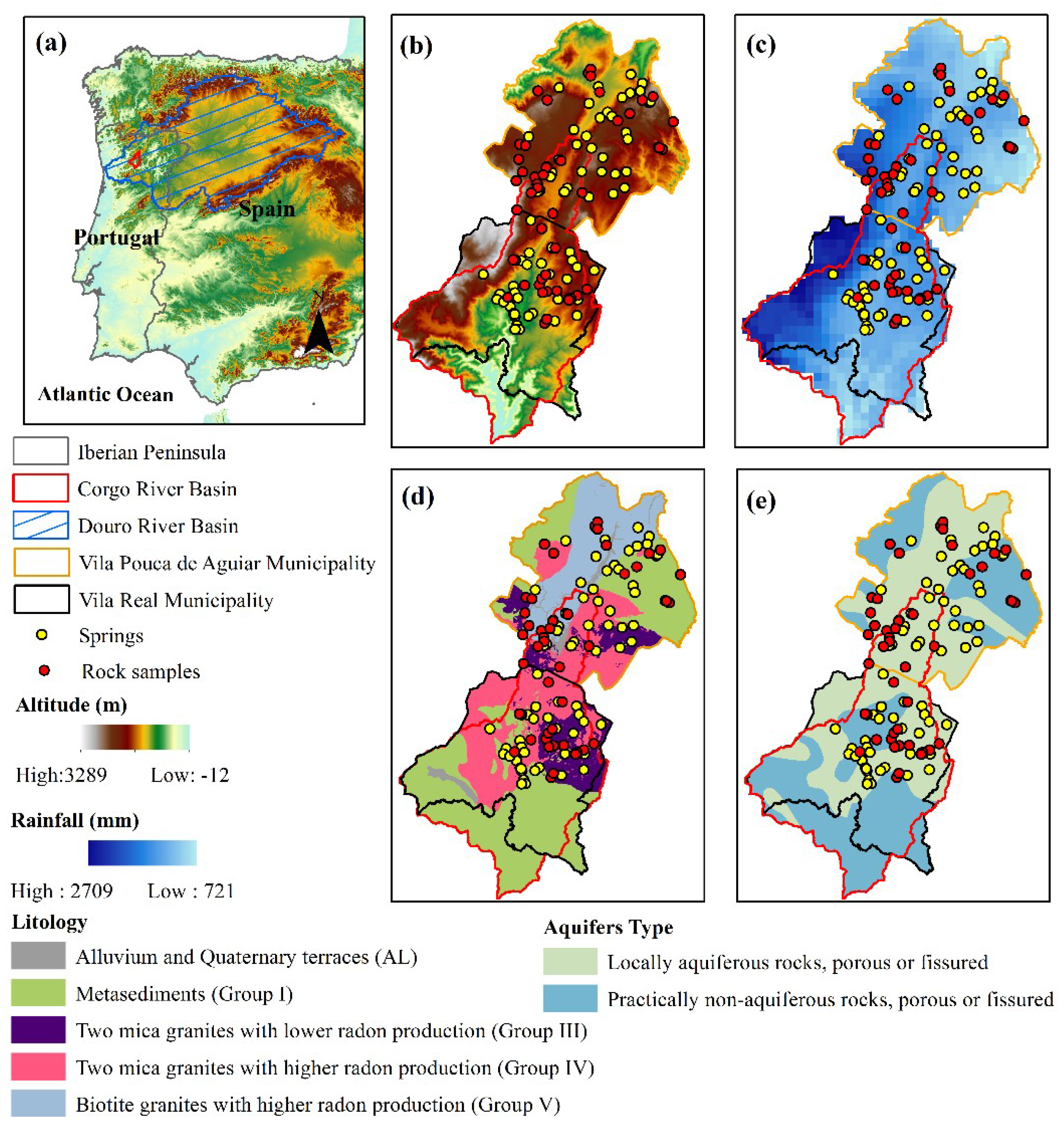
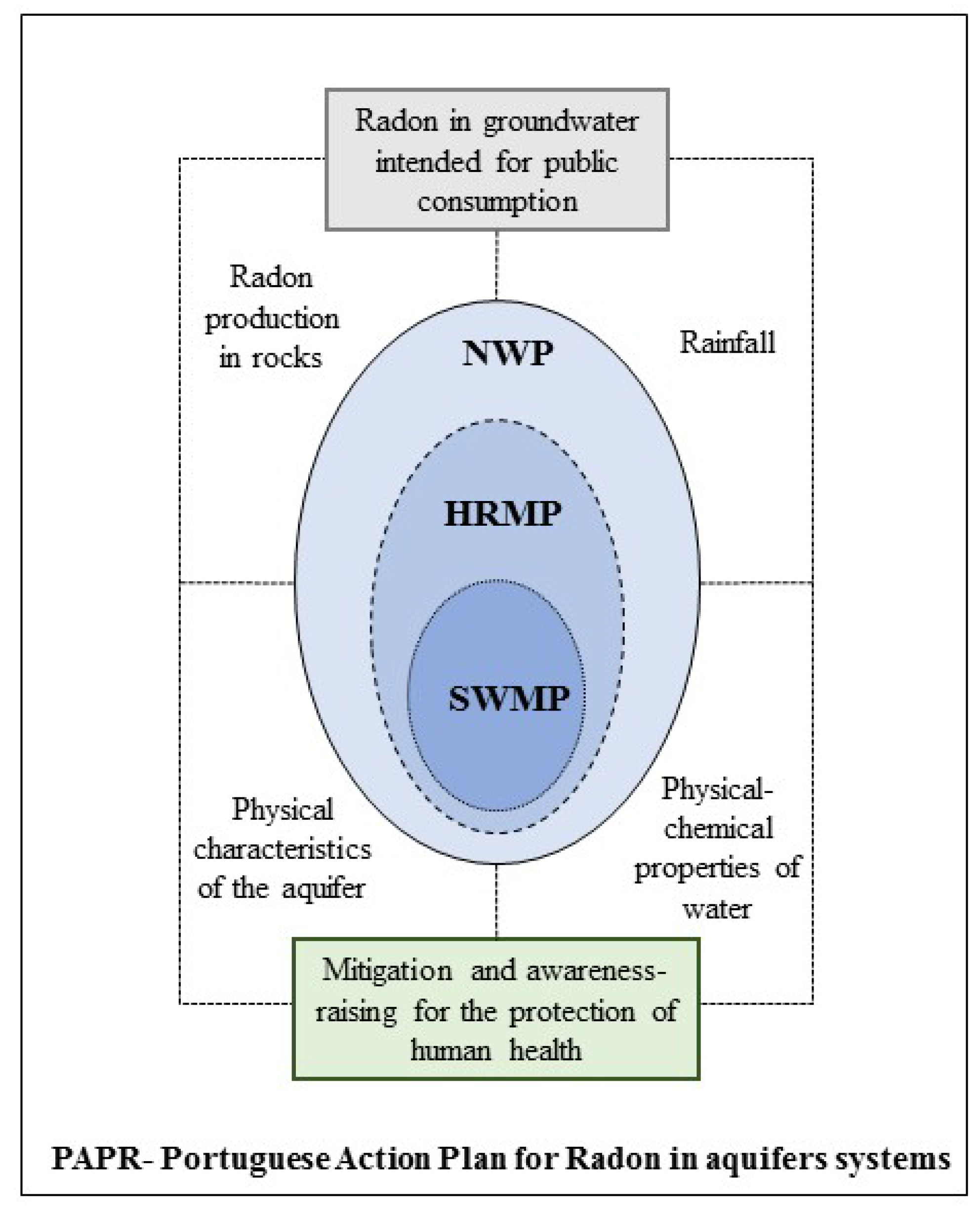
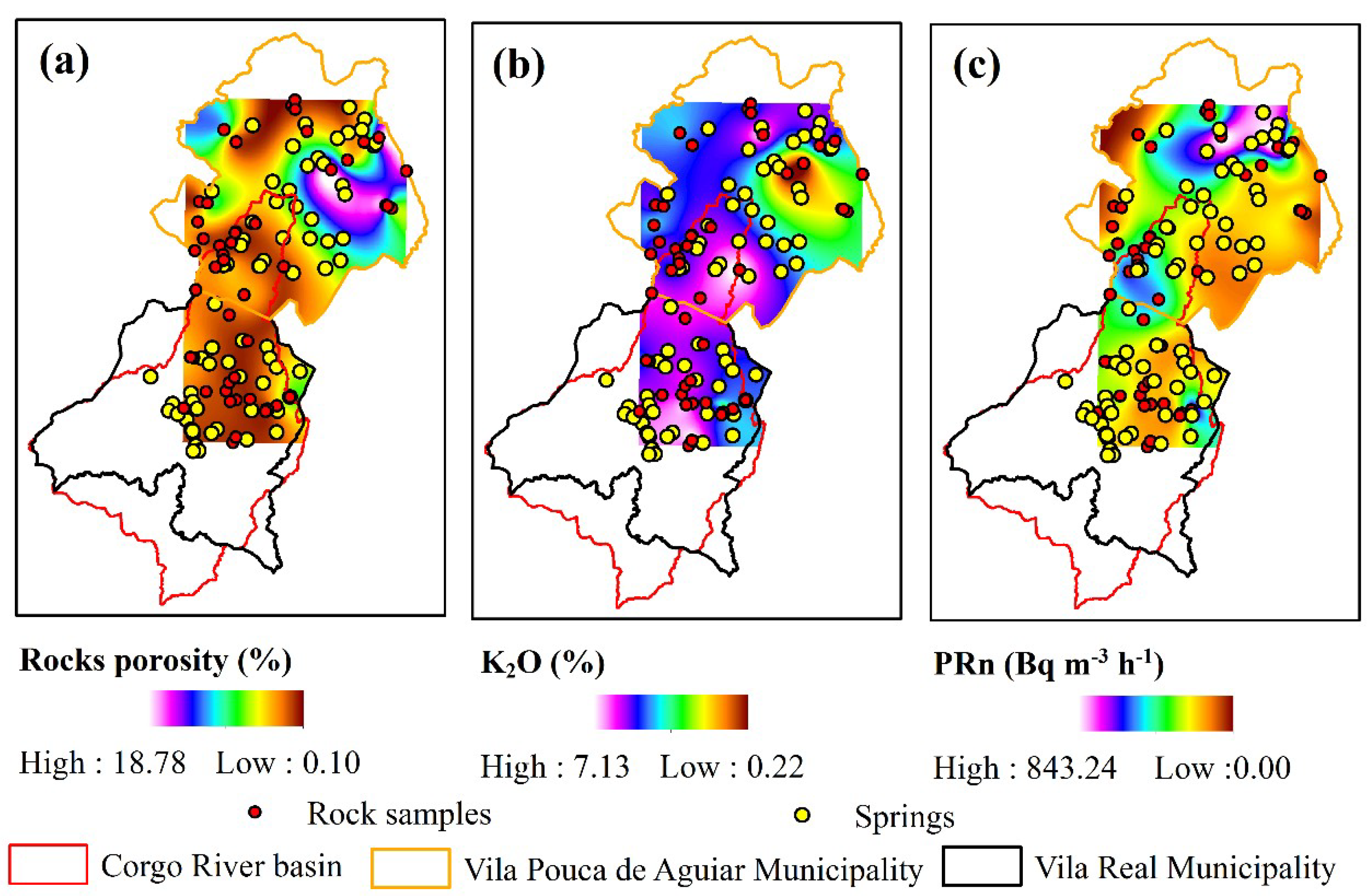
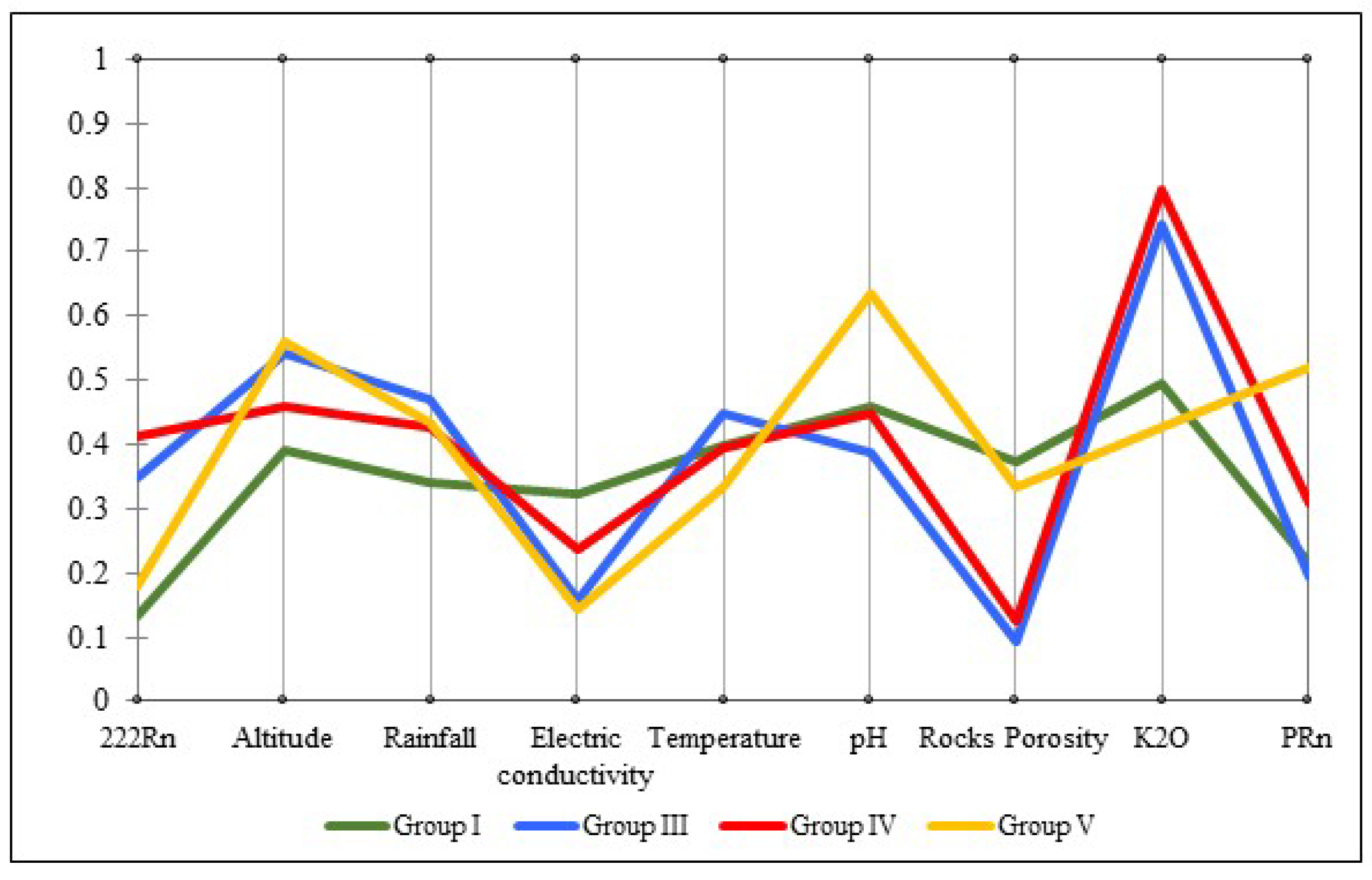
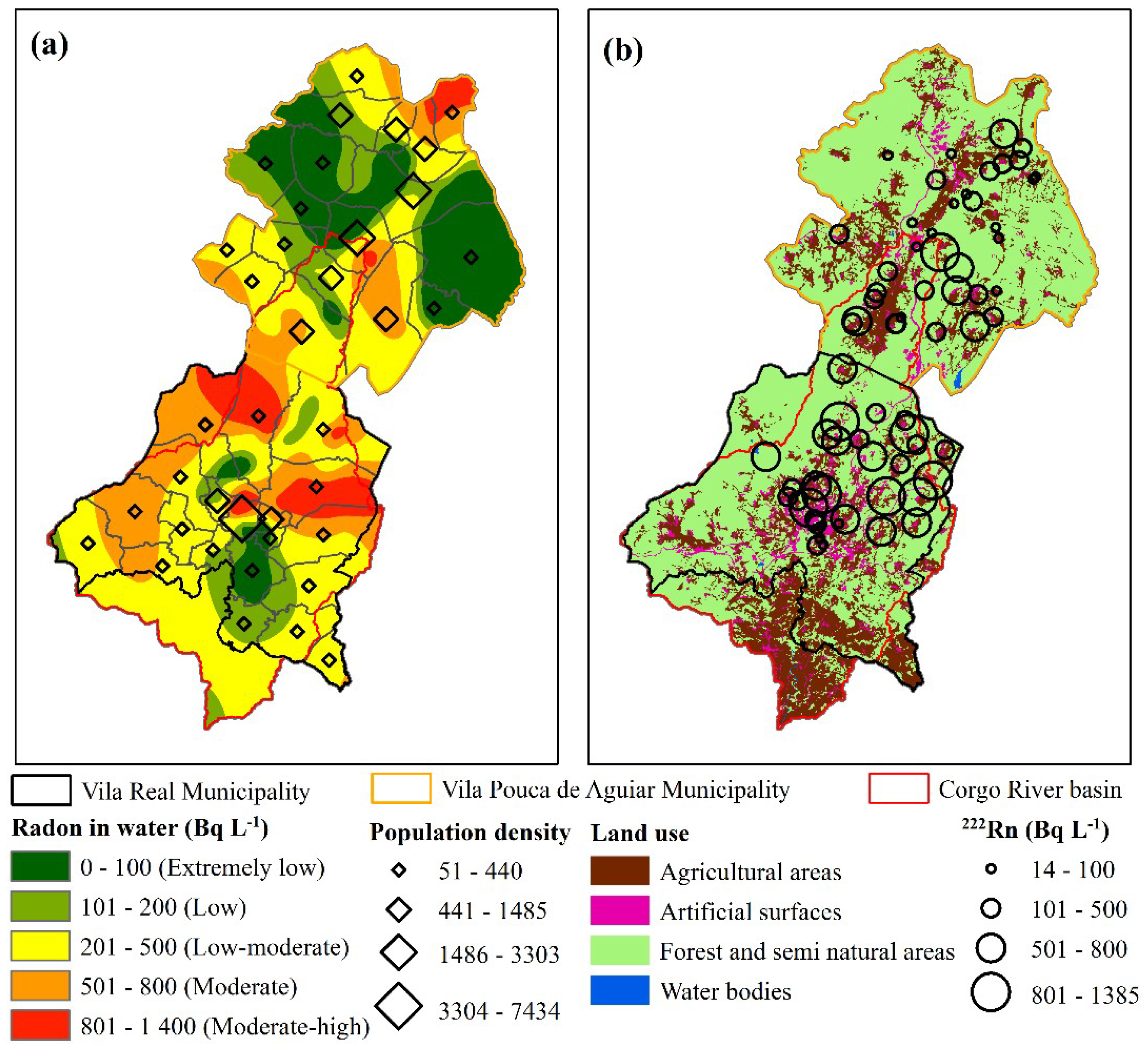
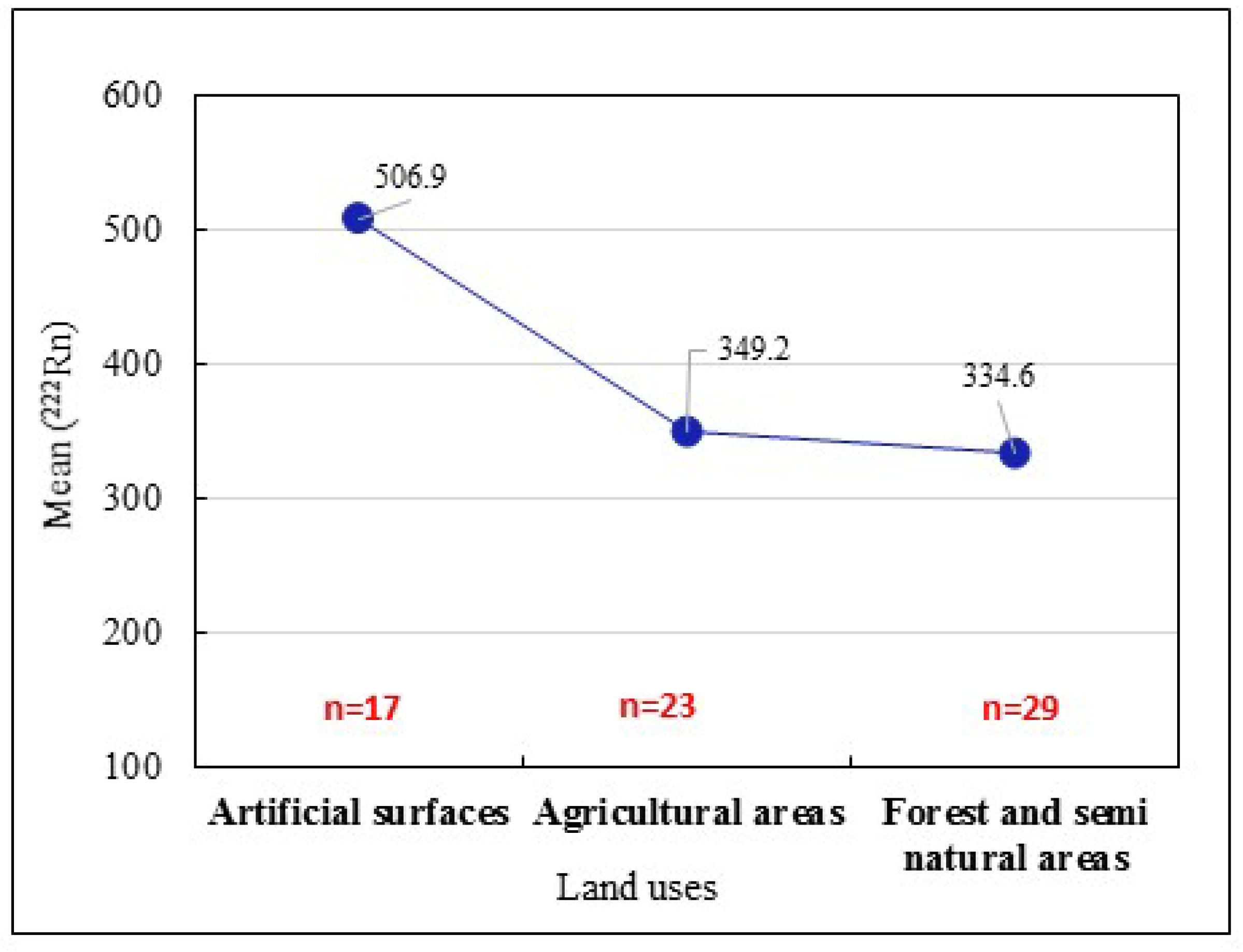
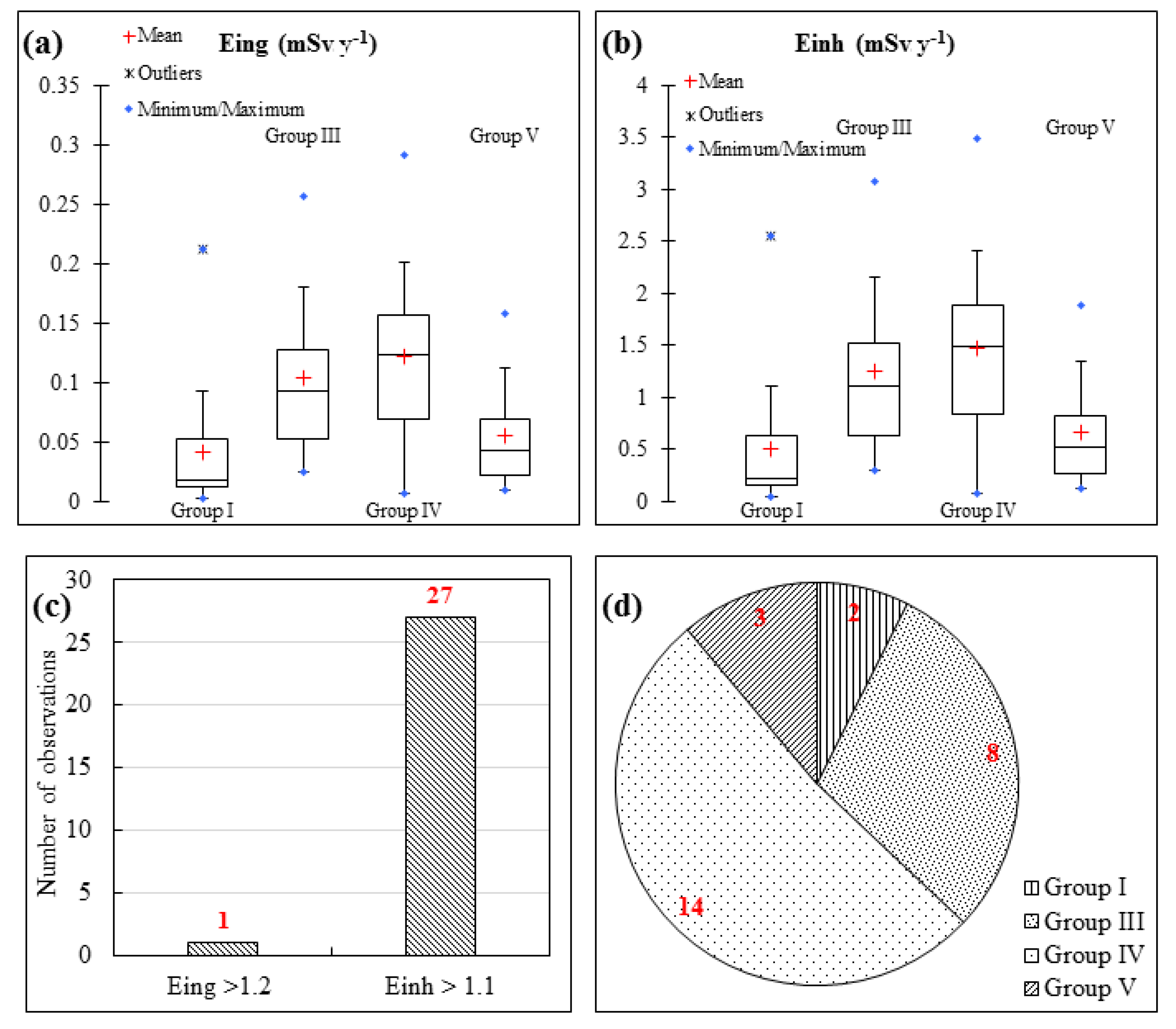
| Geology Groups | Statistics Criteria | 222Rn (Bq L−1) | A (m) | R (mm) | EC (µS cm−1) | T (°C) | pH | P (%) | K2O (%) | PRn (Bq m−3 h−1) |
|---|---|---|---|---|---|---|---|---|---|---|
| Group I | Mean | 198.2 | 654.9 | 1076.2 | 123.6 | 15.1 | 5.7 | 4.5 | 4.9 | 160.7 |
| SD | 240.8 | 213.7 | 436.7 | 105.3 | 2.7 | 0.4 | 2.8 | 0.5 | 37.4 | |
| Median | 83.0 | 602.0 | 1003.0 | 58.5 | 15.0 | 5.7 | 3.7 | 4.8 | 152.5 | |
| Min. | 14.0 | 384.0 | 453.6 | 28.7 | 11.5 | 4.7 | 1.5 | 4.2 | 95.7 | |
| Max. | 1013.0 | 1053.0 | 2275.4 | 330.0 | 22.3 | 6.3 | 9.6 | 5.7 | 234.2 | |
| n | 21 | 16 | ||||||||
| Group III | Mean | 493.6 | 760.5 | 1307.7 | 69.7 | 15.7 | 5.5 | 2.2 | 5.3 | 154.4 |
| SD | 311.9 | 82.5 | 295.2 | 58.1 | 2.7 | 0.2 | 0.6 | 0.2 | 36.9 | |
| Median | 441.0 | 760.5 | 1299.7 | 51.1 | 15.2 | 5.4 | 2.0 | 5.3 | 149.7 | |
| Min. | 116.0 | 628.0 | 597.1 | 18.1 | 12.3 | 5.2 | 1.6 | 4.8 | 100.3 | |
| Max. | 1223.0 | 879.0 | 1911.0 | 205.0 | 20.8 | 6.1 | 3.6 | 5.7 | 213.5 | |
| n | 14 | |||||||||
| Group IV | Mean | 581.3 | 702.4 | 1234.5 | 95.1 | 15.0 | 5.6 | 2.5 | 5.3 | 189.0 |
| SD | 387.7 | 191.0 | 202.2 | 98.4 | 2.8 | 0.5 | 0.6 | 0.2 | 81.2 | |
| Median | 588.5 | 729.0 | 1263.4 | 41.0 | 15.2 | 5.6 | 2.3 | 5.4 | 165.9 | |
| Min. | 31.0 | 434.0 | 607.1 | 19.1 | 10.3 | 5.0 | 1.7 | 4.8 | 110.6 | |
| Max. | 1385.0 | 1035.0 | 1553.2 | 343.0 | 21.3 | 6.7 | 4.3 | 5.7 | 397.0 | |
| n | 20 | 19 | ||||||||
| Group V | Mean | 261.1 | 773.6 | 1245.1 | 64.5 | 14.3 | 6.1 | 4.2 | 4.8 | 253.0 |
| SD | 202.3 | 148.5 | 199.1 | 42.6 | 2.1 | 0.3 | 1.9 | 0.2 | 57.8 | |
| Median | 203.5 | 724.5 | 1241.6 | 54.5 | 14.6 | 5.9 | 3.2 | 4.8 | 254.9 | |
| Min. | 46.0 | 478.0 | 833.3 | 21.2 | 10.7 | 5.6 | 2.0 | 4.6 | 163.0 | |
| Max. | 749.0 | 1078.0 | 1573.9 | 164.0 | 17.8 | 6.9 | 7.3 | 5.3 | 344.5 | |
| n | 14 | 13 | ||||||||
© 2019 by the authors. Licensee MDPI, Basel, Switzerland. This article is an open access article distributed under the terms and conditions of the Creative Commons Attribution (CC BY) license (http://creativecommons.org/licenses/by/4.0/).
Share and Cite
Martins, L.; Pereira, A.; Oliveira, A.; Sanches Fernandes, L.F.; Pacheco, F.A.L. A New Framework for the Management and Radiological Protection of Groundwater Resources: The Implementation of a Portuguese Action Plan for Radon in Drinking Water and Impacts on Human Health. Water 2019, 11, 760. https://doi.org/10.3390/w11040760
Martins L, Pereira A, Oliveira A, Sanches Fernandes LF, Pacheco FAL. A New Framework for the Management and Radiological Protection of Groundwater Resources: The Implementation of a Portuguese Action Plan for Radon in Drinking Water and Impacts on Human Health. Water. 2019; 11(4):760. https://doi.org/10.3390/w11040760
Chicago/Turabian StyleMartins, Lisa, Alcides Pereira, Alcino Oliveira, Luís F. Sanches Fernandes, and Fernando A.L. Pacheco. 2019. "A New Framework for the Management and Radiological Protection of Groundwater Resources: The Implementation of a Portuguese Action Plan for Radon in Drinking Water and Impacts on Human Health" Water 11, no. 4: 760. https://doi.org/10.3390/w11040760
APA StyleMartins, L., Pereira, A., Oliveira, A., Sanches Fernandes, L. F., & Pacheco, F. A. L. (2019). A New Framework for the Management and Radiological Protection of Groundwater Resources: The Implementation of a Portuguese Action Plan for Radon in Drinking Water and Impacts on Human Health. Water, 11(4), 760. https://doi.org/10.3390/w11040760








